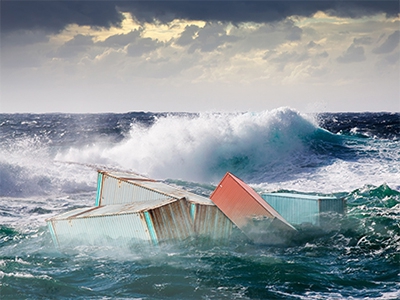Gard P&I Club’s two-part Insight article on container losses at sea
The Gard P&I Club has issued a two-part Insight article on container losses at sea. The first part of the Insight article looks into the changing approach to the environmental impact of losing containers at sea and the significant costs involved. The next article will review some of the causes of container losses and what can be done to help prevent them.
In its lastsurvey, the World Shipping Council estimated that the international liner shipping industry carried approximately 120 million containers packed with cargo in 2013. It also estimates that onaverage 1,679 containers are lost each year. Theactual figure is argued by some to be much higher.
Search and recovery
The consequences of losing containers overboard have become far greater than simply losing the value of the cargo and the container shell.
In February 2014 the SVENDBORG MAERSK wasreported to have lost 517 containers in the Bay of Biscay, 85 per cent were empty with the balance containing dry non-hazardous goods. With only 17 floating containers recovered, the French authorities ordered the ship owners to map the exact location of the containers which sank.
In the RENA incident in 2011 some 700 km of seabed were reportedly surveyed to try to find sunken containers that had floated free of the wreck. Some 35 out of 70 containers werereported to have been recovered at a cost of over USD 20 million.
In addition to the search costs in the RENA case came the expense of dealing with debris coming ashore from just four lost containers. Polyethylene beads used for bean bags were considered a visual blight on beaches. At just 2.5 millimetres in diameter, they did not pose any significant risk to public health and safety or to wildlife. Nevertheless, an order was made for their removal, which proved extremely difficult and costly. Up to 500 people, vehicles, vessels and a helicopter were deployed at areported cost in the region of USD 10 million.
Gards experience
In policy years 2013-14 Gard had five cases involving the loss of 250 containers in total. Most of these losses took place in deep, international waters well off the coast, so no search/removal orders were made, though total cargo claims ran to millions of dollars. However, a vessel which foundered at the anchorage of a West African port, was ordered to recover over 150 lost containers by the authorities.
Although search and removal orders have been few and far between, they have resulted in significant costs when made.
- In 2006, a container ship in European coastal waters lost 58 containers. The cost of seabed surveys and the recovery and disposal of beached containers and contents exceeded USD 1 million even then.
- Later in 2011, a bulk carrier lost 26 containers from its deck in the busy shipping area off China. The authorities demanded a sonar sweep of over 1,000 square kilometres, at an estimated cost of USD 4 million. An initial 24 square kilometre sweep identified 15 containers and some were salved at a cost of several million dollars.
- Following another incident in China in 2012, some 150 containers were missing. The authorities issued search and removal orders covering a 50 square kilometre area, which cost approximately USD 5 million. Close to 50 containers were recovered.
More stringent measures ahead?
Container ships with a capacity of over 19,000 TEU are now in service and over 20,000 TEU ships are on order, capable of loading with 11 tiers on deck. Following a casualty, it is questionable how quickly containers can be removed before conditions deteriorate and uncontrollable losses occur.
Following the SVENDBORG MAERSK incident, France and Spain submitted apaper to a meeting of the IMO Sub-Committee in September 2014 on Carriage of Cargoes and Containers, outlining various dangers posed to fishing activities, pollution of the marine environment and harm caused by containers containing dangerous and polluting substances. The paper calls for:
- on-board means to identify the exact number of losses
- compulsory reporting of lost containers
- where losses occur in sensitive zones, measures to precisely position containers in order to recover them where it is technically possible to do so
- for containers carrying dangerous materials, as defined in the IMDG Code, a way to facilitate the tracking of containers in order to recover them as quickly as possible and limit the risks of pollution.
Neither France nor Spain has yet ratified theNairobi Convention on the Removal of Wrecks (WRC), which came into force on 14 April 2015. The WRC provides for strict liability on the registered shipowner for the costs of locating, marking, and removing the hazard represented by the wreck of a vessel, following a lawful order of a competent authority. The WRCs definition of awreck is wide enough to include containers. The definition ofhazard is also wide, as is the area to which the WRC can apply.
| Whilst the scale of container loss and relative environmental impact is much less than other sources of pollution, it is increasingly obvious that States will not accept to have their coastlines ruined by container wreckage. There also appears to be a growing attitude among many port and costal authorities that a pure navigational hazard of sunken containers represents an unacceptable risk. In addition to the new wreck removal convention, wide enough to include containers, there are advances in container tracking and deep-sea removal technologies as well asstudies into the potential long-term (adverse) impacts of containers as a source of pollution at sea. The consequences of losing containers at sea should be of increasing concern for shipowners and operators. |
Source: The Gard P&I Club






























































